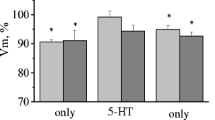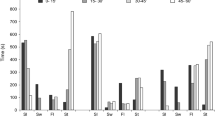Summary
Injection of disulfiram, a specific inhibitor of noradrenaline synthesis, evokes changes in two different types of neurons in the brain of Galleria mellonella: neurones containing dense-core vesicles (60–80 nm) and peptidergic cells containing 180–200 nm neurosecretory granules.
The lowering of the electron density of the dense-core vesicles of 60–80 nm seems to be directly connected with disulfiram administration, while the decrease of the amount of neurosecretory material in the neurosecretory cells of type I seems to be a secondary effect of the drug injection. The participation of noradrenaline in the regulation of the secretory activity of type I peptidergic neurosecretory cells of the pars intercerebralis is postulated.
Similar content being viewed by others
References
Borg TK, Ganger NA (1977) Ultrastructure of the protocerebral neurosecretory cells of larval Galleria mellonella in situ and after culture of the brain in vitro. Tissue and Cell 9:645–652
Cooper IR, Bloom FE, Roth RM (1970) In: The biochemical basis of neuropharmacology, Oxford Univ Press, London Toronto, pp 107–110
Cymborowski B, Dutkowski A (1970) Circadian changes in protein synthesis in the neurosecretory cells of the central nervous system of Acheta domesticus. J Insect Physiol 16:349–361
Doerr-Schott J, Joly L, Dubois MP (1978) Sur l'existence dans la pars intercerebralis d'un insecte, Locusta migratoria R. et F., de cellules neurosécrétrices fixant un antiserum antisomatostatine. C R Acad Sci 286D:93–95
Evans PD (1978) Octopamine distribution in the insect nervous system. J Neurochem 30:1009–1013
Goldstein M (1966) Inhibition of norepinephrine biosynthesis at the dopamine-β-hydroxylation stage. Pharmacol Rev 18:77–82
Heym C (1976) Monoamine storage sites in the rat superior cervical ganglion following synthesis inhibition. Cell Tissue Res 165:239–248
Holtzman E (1977) The origin and fate of secretory packages, especially synaptic vesicles. Neuroscience 2:327–355
Kniazev GG (1977) The use of disulfiram for the histochemical study of changes in brain noradrenaline levels during the action of different stimuli. Arch Anat Histol Embryol L-XXIII 8:18–23
Klemm N (1976) Histochemistry of putative transmitter substances in the insect brain. Progress in Neurobiol 7:99–169
Klemm N, Björklund A (1971) Identification of dopamine and noradrenaline in nervous structures of the insect brain. Brain Res 26:459–464
Klemm N, Falck B (1978) Monoamines in the Pars Intercerebralis — Corpus Cardiacum Complex of Locusts. Gen Comp Endocrinol 34:180–192
McCann SM, Moss RL (1975) Putative neurotransmitters involved in discharging gonatropin-releasing neurohormones and the action of LH-releasing hormone an the C.N.S. Life Sci 16:833–852
McCann SM, Kalra PS, Donoso AO, Bishop W, Schneider HPG, Fawcetts CP, Krulich L (1972) The role of monoamines in the control of gonadotropin and prolactin. In: Knigge KM, Scott DM and Weindl A (eds) Brain-Endocrine Interaction, 224–235. Basel, Karger
Peters A, Palay SL, Webster HF (1976) In: The fine structure of the nervous system: the neurons and supporting cells. WB Saunders Comp, Philadelphia London, 107–112
Remy C, Girardie J, Dubois MP (1979) Vertebrate neuropeptide-like substances in the suboesophageal ganglion of two insects: Locusta migratoria R. and F. (Orthoptera) and Bombyx mori L. (Lepidoptera) Immunocytological Investigation. Gen Comp Endocrinol 37:93–100
Robertson HA (1976) Octopamine, dopamine and noradrenaline content of the brain of the locust, Schistocerca gregaria. Experientia 32:552–554
Samaranayaka M (1976) Possible involvement of monoamines in the release of adipokinetic hormone in the locust Schistocerca gregaria. J Exp Biology 65:415–425
Schmitt FO (1968) The molecular biology of neuronal fibrous protein. Neurosci Res Progr Bull 6:116–144
Taus L (1979) Are vesicles necessary for release of acetylcholine at cholinergic synapses? Biochem Pharmacol 27:3493–3498
Wartoń S (1977) Monoamine-containing cells in the brain of Galleria mellonella, Lepidoptera. Acta Med Pol 18, 4:381–383
Wartoń S, Dutkowski A (1977) Ultrastructure of the neurosecretory cells of the pars intercerebralis of Galleria mellonella (Lepidoptera) after noradrenaline administration. Gen Comp Endocrinol 33:179–186
Wartoń S, Dutkowski A (1978) Ultrastructural analysis of the action of reserpin on the brain neuroendocrine system of the wax moth Galleria mellonella, Lepidoptera. Cell Tissue Res 192:143–155
Zimmerman M (1979) On the vesicle hypothesis. Trends in Neurosci 2, 11:282–285
Author information
Authors and Affiliations
Additional information
The author is grateful to Prof. S. Niemierko for her critical review of the manuscript and to the engineering staff of the Electron Microscopy Laboratory for its technical help
Rights and permissions
About this article
Cite this article
Wartoń, S. Effect of disulfiram on the ultrastructure of the peptidergic and aminergic cells in the pars intercerebralis of Galleria mellonella (Lepidoptera). Cell Tissue Res. 215, 417–424 (1981). https://doi.org/10.1007/BF00239124
Accepted:
Issue Date:
DOI: https://doi.org/10.1007/BF00239124




